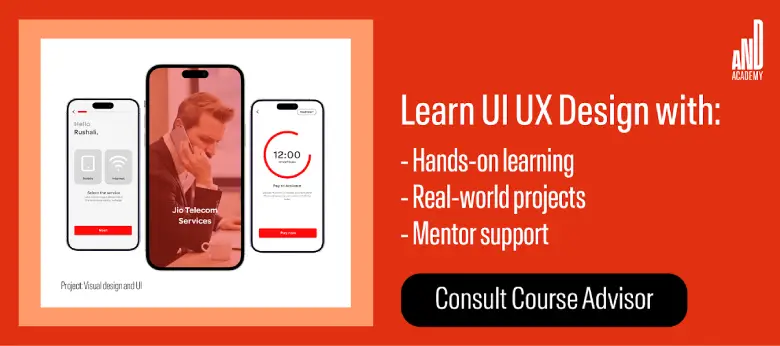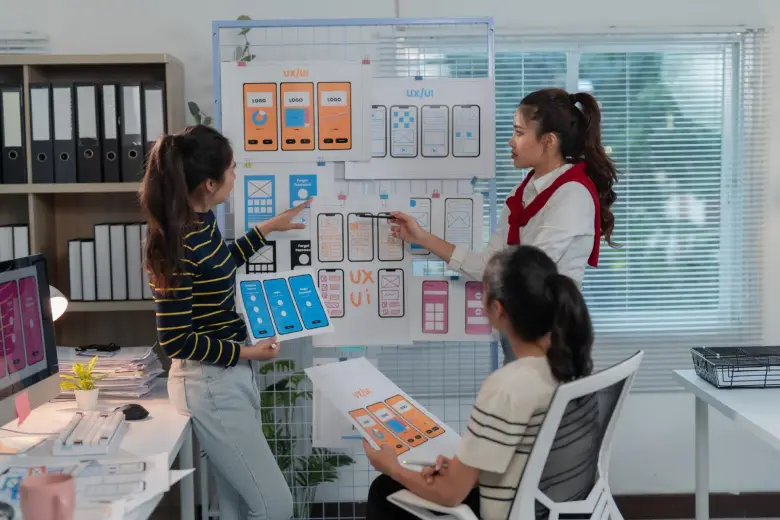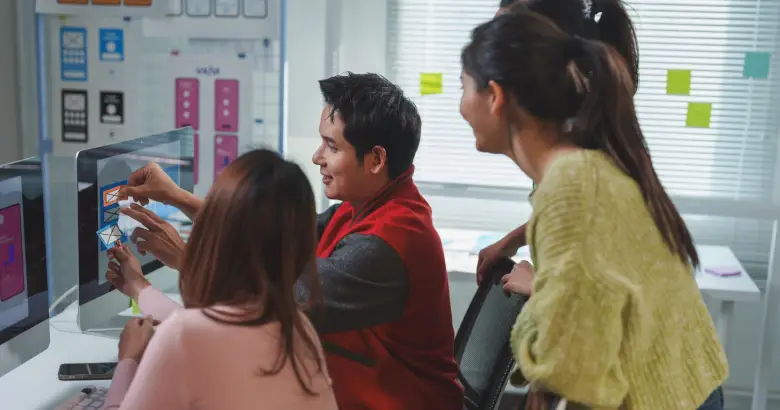What is Agile UX, and how could it benefit your designs and users? Learn more about this increasingly popular design methodology transforming workflows across sectors.
As every business owner will tell you, providing seamless, user-friendly designs is make or break when it comes to retaining users and standing out from competitors in a fierce marketplace. A product that meets the goals, needs, desires, and preferences of users while helping to solve challenges is no longer considered a nice extra; it’s paramount to business success.
As user experience has gained more attention, so have the methodologies helping to make it the best it can be. This is where Agile UX comes in. Agile UX is transforming how teams work together, moving the focus away from strict, long-term planning and towards rapid iteration, collaboration, and ongoing feedback. By adopting this approach, companies ensure that the user stays at the center of design decision-making, leading to products that meet genuine user needs.
But how does Agile UX differ from other design approaches, such as Lean UX? In this guide, we’ll explore what Agile UX is, its core principles, and how it differs from Lean UX. We’ll walk you through the Agile UX process, highlight its advantages and challenges, and give you the tools to implement it in your design workflow.
- What is Agile UX?
- What is Lean UX?
- Key similarities and differences between Agile UX and Lean UX
- Principles of Agile UX
- The Agile UX process
- Pros and cons of Agile UX
- Conclusion

What is Agile UX?
When answering this question, it’s important to establish what we mean by Agile in a general sense and then examine how this methodology is applied to the UX design process. Let’s dive in.
What do we mean by Agile?
Agile is a hugely popular project management methodology common to development and design teams. It involves projects being broken down into smaller phases or tasks. It emphasizes continuous iteration, collaboration, and improvement, with teams following a defined cycle of planning, execution, and evaluation.
Agile organizations are made up of an interconnected network of technology-forward teams that prioritize an empathetic working culture, rapid learning, and fast decision-making. When implemented with care, Agile processes speed up a team’s progress and make them more adaptable. This is particularly beneficial when it comes to staying competitive in the market and thriving in uncertain conditions.
What is Agile in UX design?
Agile UX is when agile principles such as collaboration, iterative development, flexibility, and data-driven decisions are applied to the UX design process. This dynamic approach to the UX design methodology helps different teams across an organization to communicate and work together effectively, adapt quickly to unexpected changes, and craft user-centric products that meet users’ needs.
A core part of Agile UX design is recognizing that user needs, preferences, behaviors, and requirements shift and evolve over time and that, in order to be competitive, a team needs to embrace constant change and uncertainty. They do this by incorporating a methodology that sees the design team testing and iterating on their projects continuously. By working in this way, a design team can quickly identify potential challenges or pain points earlier on in the process. Not only does this iterative and experimental approach foster a culture of continuous improvement, but it also saves the company significant time and resources in fixing issues later on.

What is Lean UX?
Lean UX has roots in both Lean Startup and Agile development. It is a collaborative approach to design that seeks to streamline the process by minimizing wasted time and delivering value to users as quickly as possible. It does this via a product development lifecycle based on swift, data-backed decision-making, continuous testing, ongoing feedback, extensive prototyping, and continuous iteration.
Building and testing ideas quickly is at the heart of Lean UX, with any documentation or processes that could slow down this effort being de-prioritized or removed entirely. By promoting the fast flow of ideas and a “fail fast” mentality, UX designers have room to try out their ideas and experiment more freely. Rather than striving to produce a perfect solution to a user challenge, teams are instead encouraged to embrace the ambiguity of the process and results, make decisions quickly, and learn from real users as early on in the process as possible to gain valuable insights and feedback on the elements of their product that are working and elements that are not.
An essential process in Lean UX is the creation of MVPs (Minimum Viable Products). These are low-fidelity designs used to support rapid experimentation during early-stage user testing to gather insights and feedback quickly. These sketches are far from being a final product or even a working prototype, and neither are they intended to be. Instead, they serve to communicate the design in its infancy to users and stakeholders. Feedback on these ideas helps the designer make improvements and changes for another round of iteration. This fast design and development lifecycle–creating an MVP, getting feedback, and iterating on the product–is the essence of Lean UX.
What are the key similarities and differences between Agile UX and Lean UX?
Agile UX and Lean UX share a number of principles which can make them hard to tell apart. Here, we outline what the two approaches have in common and how they differ so you can determine the best approach for your project or team.
1. Similarities between Agile UX and Lean UX
Both Agile UX and Lean UX:
- Place great importance on remaining flexible to changes throughout the design process, keeping detail and documentation to a bare minimum while early-stage products are tested and iterated upon
- Put the user at the center of their methodologies, seeking to meet user needs and prioritizing their experiences
- Seek to reduce information silos (information stockpiling by one team or another) and instead encourage ongoing multi-team communication and collaboration
- Are utilized within iterative cycles that foster continuous improvement with constant user testing and product refinement
- Seek to actively include stakeholder input at every stage in the process
2. Differences between Agile UX and Lean UX
The core differences between these two design approaches are:
- Agile UX emphasizes the importance of bringing users in for testing and research, using the insights gathered to inform decisions about the product, whereas Lean UX prioritizes the development of MVPs to validate hypotheses early on.
- Agile UX involves a user-centered design approach within an Agile sprint, leading to improvements based on user feedback, while Lean UX aims to communicate issues across teams, which leads to prototype development and iteration.
- Agile UX promotes the development of prototypes in tandem with the product during design sprints, with prototypes being changed, tweaked, and improved as the project progresses. Lean UX, on the other hand, encourages the development of low-fidelity prototypes early on in the process, ready to test out early solutions quickly.
- Agile UX design endorses collaboration primarily between designers and developers as a project unfolds, while in Lean UX, cross-functional collaboration between all team members and teams is highly prioritized.
- While Lean UX champions gathering ongoing user feedback and the implementation of real-time product adjustments, Agile UX tends to focus on collecting user feedback mostly during sprint reviews rather than continuously through the product development lifecycle.
- Agile UX has a more rigid approach to sprint cycles, commonly incorporating hard deadlines for specific deliverables, while Lean UX is all about flexibility, placing greater emphasis on experimentation over timelines or results.
- While Lean UX endorses continuous collaboration between design and development teams from the first day of the project, in Agile UX, the UX design process tends to be integrated into Agile sprints, but designers experience varying levels of influence over the development of the product.

Principles of Agile UX
What are the core principles of Agile UX? We run through the fundamentals of the methodology that you can apply to your workflows.
1. Iterative process
Iteration is an essential component of the UX design process in general. However, in Agile UX even greater importance is placed on this element of the methodology. Iteration simply refers to repeating processes in a cyclical fashion in order to refine and evolve the design as far as possible. This approach prevents design teams from committing to a single design solution from the start and instead advocates for a system of small, incremental updates based on extensive user feedback, prototyping, testing, and analysis. The benefit of approaching a design project this way is that the design matches or adapts to changing user needs and market conditions. Rather than having to overhaul the whole design every time an issue arises, the design team instead spots challenges more quickly and earlier on in the process, enabling them to respond swiftly and with fewer changes.
2. Collaboration
Agile UX encourages designers to work closely with other teams, integrating a host of expertise from across the board into the final design solution. From other designers and developers to product managers and stakeholders, teams exchange regular updates and feedback to ensure everyone’s aligned with the project’s progress and has a full understanding of any required input. When collaboration and communication across teams are prioritized, the design team reaps numerous benefits that ultimately improve their final outcome. These include:
- A shared understanding of the problem being addressed and possible solutions
- Input from experts in different fields who may highlight issues that could otherwise go unnoticed
- Early identification of issues or potential challenges
- Reduction in misunderstandings, miscommunication, silos, and bottlenecks
- User experience remains a high priority (because all teams have this as their goal)
- Enhanced creativity and innovation thanks to a wider range of voices being heard
3. Data-driven decision-making
While it can certainly be tempting to use intuition as the basis for decision-making in design (and in life!), any designer worth his or her salt will tell you that design ideas or solutions should always be validated using data and analysis. Why? Because, although our intuition feels right to us, it fails to take into account the broad range of experiences, needs, preferences, and behaviors of our users. To understand these things, the design team performs extensive and ongoing user research and user testing, leveraging the quantitative and qualitative data that emerges to inform their decisions. When this is done effectively, purposeful and effective solutions are found to user problems. In addition, when research and testing are part of the iterative design cycle, teams can pivot quickly based on real-time user data, which mitigates wasted time or resources.
4. Flexibility
Being able to respond quickly to change is an important part of Agile UX. With both user preferences and market conditions shifting at speed, designers are expected to value responsiveness and flexibility over rigid planning or timelines in order to craft a solution that meets the new conditions. Teams using an Agile UX approach revisit a design again and again, incorporating new feedback, data, ideas, and insights. Priorities must be continually adjusted to address emerging requirements or changes without compromising the speed of development. Teams are encouraged to be innovative and flexible and respond to internal and external shifts throughout the entire project lifecycle to ensure the best –and most relevant– result.

The Agile UX process
Let’s run through the main steps design teams take when working with the Agile UX process to design or redesign a product.
1. Planning and defining user stories
The first step in the Agile UX process is planning and defining user stories. This involves aligning the process of designing and developing a product with the needs, preferences, goals, and expectations of target users.
To do this, the design team collaborates closely with all project stakeholders to pinpoint which design features and functionalities support users most effectively. Once the important elements have been identified, the team creates user stories. These are simple descriptions of a feature written from the perspective of the user that include a breakdown of how the feature would be created in incremental steps.
By creating user stories, the team has more empathy for the user and stays focused on solving real user problems. In addition, by breaking down the process into small steps, the team is in a better position to stay flexible should anything about the project change during the development cycle.
2. Designing and prototyping in short cycles
Short cycles are at the heart of Agile UX, and the acts of designing and prototyping are no exceptions. Designing and prototyping solutions occurs in short, iterative cycles with low-fidelity prototypes created early and often by the team. This approach gives designers the advantage of quickly visualizing their concepts and testing alternative ways of doing things. This more experimental approach gives teams the chance to explore innovative design possibilities without wasting time or resources. It also gives project stakeholders tangible mockups to review, allowing them to assess how successfully the project is progressing.
Designing and prototyping in short cycles is the preferred method of Agile UX teams as they can focus on specific parts of the project at a time, try out new ideas at a lower risk, and ensure that not too much time is lost on ideas that may not be used in the final design. Working in short cycles also ensures continuous, incremental progress without sacrificing adaptability should anything change, like user needs or business goals.
3. Testing and gathering feedback
Designers use a range of techniques to gather data from users that influence their design solutions. Once prototyping is completed, the design team might conduct testing sessions, interviews, surveys, user observation sessions, and focus groups to try to determine how well the product meets user needs and pinpoint any potential challenges.
By regularly testing and gathering quantitative and qualitative feedback from users, teams can keep making tweaks and adjustments to their product as they move to the next stage of the process. This ensures that the design remains user-centered and meets user expectations and needs without compromising business goals.
4. Refining and iterating based on feedback
With the quantitative and qualitative feedback from users fresh in their minds, the design team considers the product again. Guided by the insights gathered, they refine the product and make improvements, sometimes even revisiting much earlier stages of the design process to overhaul or fix issues that went unnoticed before. From making small tweaks and testing new hypotheses to totally reworking elements of the product that are not working for the user, the team refines and iterates the product until they are confident that they have enhanced the user experience and created a design solution that is fully functional, intuitive, and solves user challenges.

Pros and cons of Agile UX
What are the benefits and pitfalls of using Agile UX for design teams? We’ve rounded up reasons to consider incorporating the methodologies as well as some reasons for caution.
Pros
1. Faster time to market
Thanks to the iterative approach that Agile UX advocates for, features and products can be delivered significantly more quickly. Usable versions and interactive prototypes can also be produced more swiftly for testing and research purposes due to the short, focused cycles that make up the process.
2. Increased flexibility
The flexible approach encouraged in Agile UX enables teams to adjust designs easily and in direct response to changing market conditions and evolving user needs. This flexibility in the process results in a final product that still aligns closely with current user needs and business requirements.
3. Improved user satisfaction
Users tend to be happier with products produced as part of the Agile UX process because user needs are at the forefront. The continuous feedback loop ensures the product meets user needs, preferences, and desires and that improvements to the product are based on real-world usage.
Cons
1. Lack of long-term vision
A criticism of the Agile UX process is that, due to the razor-sharp focus on quick and regular development and feedback cycles, the long-term vision or goal for a product can get lost. This may result in a lack of continuity, consistency, or even coherence in the user’s overall experience with the product. It is even more likely to be the case when different teams of designers are working simultaneously on different product features or functionalities.
2. Requires a lot of resources
While Agile UX product development cycles emphasize speed, they also require different skills and resources for each cycle in order to achieve such fast and regular iteration. This requires generous budgets and teams of designers and stakeholders with time to commit to the process. Without this commitment of resources, teams may not benefit from adopting the approach.
3. Scope creep
Scope creep, where new features are continually being added in response to user feedback or stakeholder requirements, is a frequently occurring problem in the Agile UX design process due to the emphasis on regular iteration and feedback. When scope creep isn’t monitored carefully, it can result in missed timelines, compromised product quality, and a chaotic user experience.
Conclusion
The Agile UX process is a highly flexible and fast approach to design that promotes incorporating regular user feedback, continuous iterations and improvements, and on-going testing in short, swift development cycles. As we’ve seen, this approach can support the development of a more user-centric product and the early identification of potential issues, as well as nurturing a more collaborative working environment for designers, developers, and other project stakeholders.
We hope you’ve enjoyed our complete guide to this innovative and effective approach to UX design. If you’re thinking of trying it yourself, be sure you have the resources in place before you start to avoid compromising on your design solution, keep an eye on ‘scope creep’ and stick to features that truly add value to the user, and be sure to regularly and clearly communicate to all team members the vision for the product and the problem it should solve, thus avoiding the goal for the project getting lost along the way.
Next Steps
If you’d like to learn more about UX design, check out more of our articles over on the AND Academy Design Blog. You can also check out this project by AND Learner, Vikas Sen, for more insights into the applications of UI UX design.
In case you think you need further assistance, here are some of our resources you can consider:
- Watch this session by Shiva Viswanathan, Design Head of Ogilvy Pennywise, and Naman Singh, Product Experience Designer at RED.
- Talk to a course advisor to discuss how you can transform your career with one of our courses.
- Pursue our UI UX Design courses – all courses are taught through live, interactive classes by industry experts, and some even offer a Job Guarantee.
- Take advantage of our scholarship and funding options to overcome any financial hurdle on the path of your career transformation.
Note: All information and/or data from external sources is believed to be accurate as of the date of publication.









